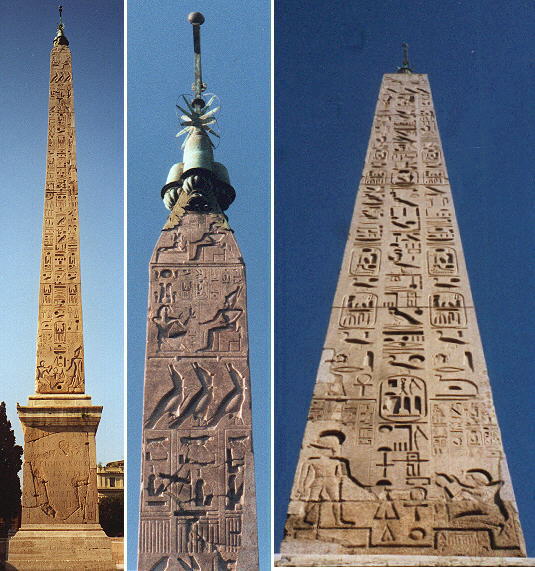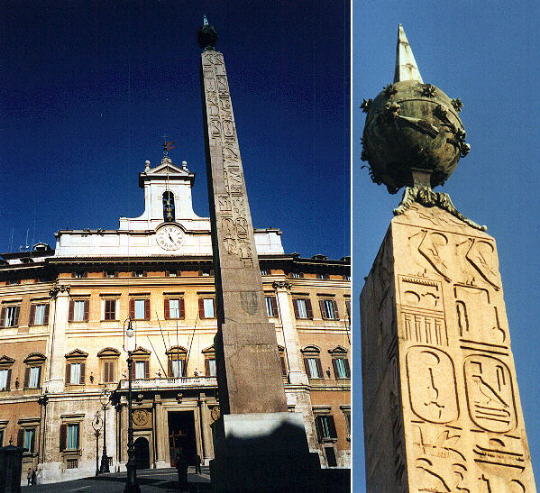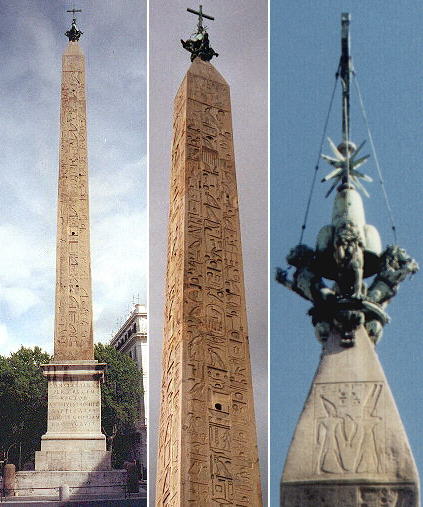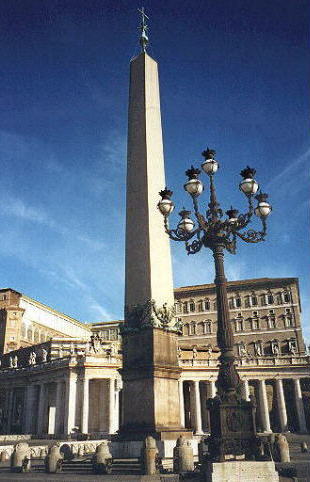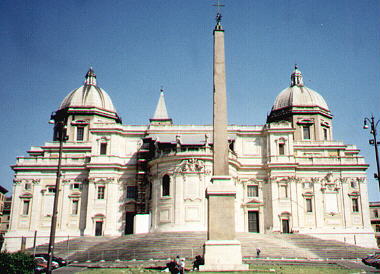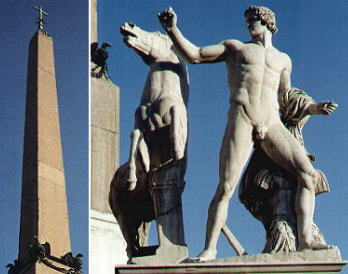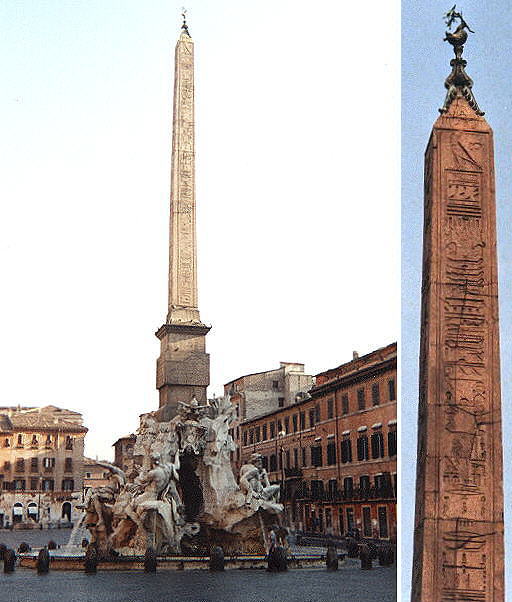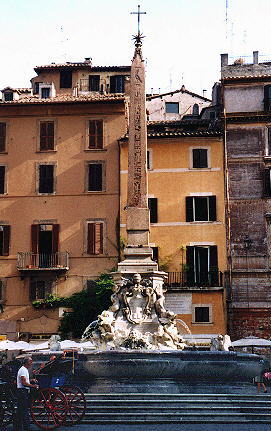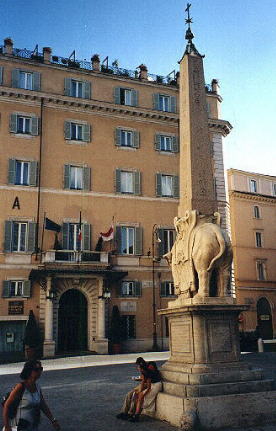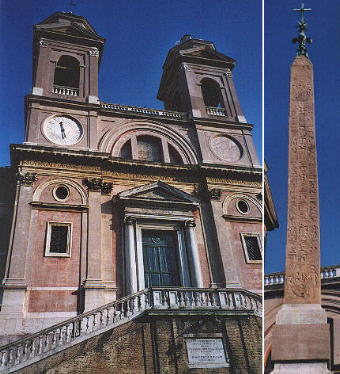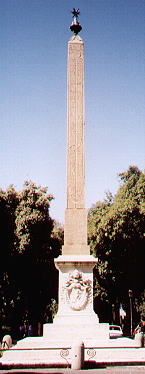  OBELISKS OF ROMELove at First Sight
In 241 B.C. the Romans conquered Sicily in the course of their first war against Carthage. The possession of this island at the center of the Mediterranean Sea led to the first contacts with
the Egyptian Empire, which was ruled by a Greek dynasty, the Lagides, after Lago a general of Alexander the Great. The Lagides are more often referred to as the Ptolemies, Ptolemy being the recurring name of their Pharaohs.
The rise of Rome in the Mediterranean did not lead to confrontation with Egypt, although the internal
quarrels among the members of the Egyptian dynasty gave Rome some say in the internal matters of Egypt.
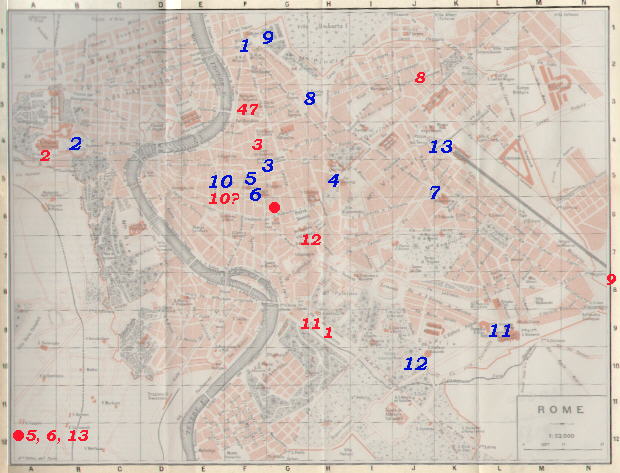
1912 Map of Rome - Blue numbers are clickable and show the current location of the obelisks - Red numbers show the original location of the obelisks All the obelisks are no longer in the site where they were erected by the Roman Emperors. In the XVIth century most of them were broken into pieces and they were just another component of the picturesque view of the Roman ruins. They were saved by Sixtus V (1585-90) who used them as focal points for some of the new streets he opened as part of his plan of urban development. Several obelisks were repaired, turned from pagan to Christian monuments by the addition of new inscriptions, topped with a cross and with the heraldic symbols of the pope and eventually moved to the center of a piazza or in front of a basilica.
Obelisk of Rameses II in Piazza del Popolo (No. 1 in the map)
The obelisk was initially erected by the Pharaoh Rameses II in Heliopolis. In 30 B.C. Augustus brought it to Rome where it was put at the center of Circus Maximus and dedicated to the Sun (in line with its original dedication). It fell during the wars between the Byzantines and the Goths for the control of Rome in the VIth century A. D. and it was covered by debris. In 1587 the area was excavated and the obelisk was repaired (it was slightly shortened) and moved in 1589 to Piazza del Popolo at a point where three streets (Via di Ripetta, Via del Corso and Via del Babbuino) converge to form il Tridente di Roma. It is topped by the mountains and the star of Sixtus V.
Obelisk of Psammetichus II in Piazza di Montecitorio (No. 3 in the map)
The obelisk was originally erected by Psammetichus II in the 7th century B.C. and then brought to Rome by Augustus who placed it as a sundial in a vast square (Horologium Divi Augusti) where its shadow indicated the hours of the day and the days of the year. The obelisk was found split in five pieces in 1748 and it was eventually repaired and erected in front of Palazzo di Montecitorio. The reliefs are partially lost. Pius VI put on top of the obelisk a symbol of his coat of arms, but he added a peak as a reminder of its use as sundial.
Obelisk of Thothmes IV in Piazza S. Giovanni in Laterano (No.11 in the map)
This is the tallest obelisk of Rome and also the last to be brought from Egypt. Both Augustus and Constantine considered bringing it to Rome
from Thebes, where it had been erected by the Pharaoh Thothmes IV. In 357 A.D. the Emperor Constantius II was able to arrange its
transportation by using a specially built ship.
It was located in the Circus Maximus, where it was found broken into three pieces in 1587. It was moved to Piazza S. Giovanni in Laterano in 1588 by
Sixtus V who wanted its top to be decorated with the whole array of his
heraldic symbols: not only the three mountains with the star, but also the lion
holding the pears. It is one of the best
preserved obelisks, with very fine hieroglyphs.
Obelisk of Augustus in Piazza S. Pietro (No. 2 in the map)
The obelisk was erected in Alexandria by the Romans in the Ist century B.C. and it was dedicated to Augustus. It does not have any inscription in hieroglyphs. It was moved to Rome by Caligula who placed it in the Circus he had built in the Vatican (the Circus was later on named after Nero). The obelisk never fell and this fact in the Middle Ages was attributed to the reputation of Nero as a sorcerer. It was topped by a bronze globe which was thought to contain the ashes of Caesar, Augustus and Tiberius. In 1586 Sixtus V ordered Domenico Fontana to relocate it in front of St. Peter's. So the Obelisk was the first element of the Piazza. The top of the obelisk is decorated with the mountains and the star of Sixtus V.
Obelisks of Augustus in in Piazza dell'Esquilino (No. 7 in the map) and in Piazza del Quirinale (No. 4 in the map)
The obelisks were erected in Rome at the entrance of the Mausoleo di Augusto (they do not have hieroglyphs). Augustus had visited in Alexandria the tomb of Alexander the Great and he decided to build his family tomb taking into account some aspects of the tomb of Alexander. Both obelisks fell into pieces and as the area was often flooded they disappeared into the ground. In 1519 the opening of Via di Ripetta led to the discovery of one of them. It was broken into four pieces which were assembled near the church of S. Rocco. Sixtus V (1585-90) had the obelisk repaired and placed (1587) at the end of Strada Felice a new street he had opened to reach S. Maria Maggiore. The top of the obelisk is decorated with the mountains and the star of Sixtus V. In 1781 the second obelisk was discovered; it was broken into three pieces and it was repaired and placed (1786) by Pius VI in Piazza del Quirinale between two existing colossal statues.
Obelisk of Domitian in Piazza Navona (No.10 in the map)
The obelisk was erected by Domitian after the fire which had destroyed a large part of Rome in 80 A.D. and most likely it decorated the Isaeum/Serapeum Campense a large
complex of Temples dedicated to the Egyptian gods Isis (hence Isaeum) and Serapis (hence Serapeum) in Campus Martius. Its hieroglyphs are related to the cult of these gods.
In 309 A.D. Maxentius moved the obelisk to the circus built in honour of his son Romulus near Via Appia. The obelisk fell in the
VIth century and it broke into five pieces. In 1648 the obelisk was repaired and in 1649 it was erected on top of the fountain designed by Gian Lorenzo Bernini to celebrate
the glory of Innocentius X (1644-55). Bernini had not
been invited to submit a project for the fountain, as the Pope reproached him for his too close
connection with his predecessor Urbanus VIII and for the technical failure of his attempt to
erect St Peter's bell towers. Bernini found a way to have a model of the fountain seen by the Pope and
he immediately got the commission. The top of
the obelisk is decorated with the dove of Innocentius X.
The Isaeum/Serapeum Campense covered a large area between the Pantheon and Via Flaminia (today Via del Corso)
and it was embellished with several small size obelisks all coming from Egypt.
The obelisk opposite SS. Trinitŕ dei Monti was initially erected in a private residence called Horti Sallustiani after the name of its first owner, the Latin
historian Sallustius, a very wealthy man. The Horti Sallustiani covered a large area near Porta Pinciana and
Porta Salara, which later on became part of Villa Ludovisi. It is a small scale copy of the obelisk of
Rameses II, now in Piazza del Popolo and it was made in Rome. It was moved by Pius VI in 1789 to its current location.
The top of the obelisk shows a lily and a star which are heraldic
symbols of Pius VI.
Go to my Home
Page on Baroque Rome or to my Home Page on Rome
in the footsteps of an XVIIIth century traveller.
|
